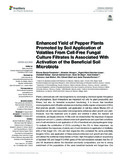Mostrar el registro sencillo del ítem
Enhanced yield of pepper plants promoted by soil application of volatiles from cell-free fungal culture filtrates is associated with activation of the beneficial soil microbiota
| dc.creator | Baroja Fernández, Edurne | es_ES |
| dc.creator | Almagro Zabalza, Goizeder | es_ES |
| dc.creator | Sánchez López, Ángela María | es_ES |
| dc.creator | Bahaji, Abdellatif | es_ES |
| dc.creator | Gámez Arcas, Samuel | es_ES |
| dc.creator | Diego, Nuria de | es_ES |
| dc.creator | Dolezal, Karel | es_ES |
| dc.creator | Muñoz Pérez, Francisco José | es_ES |
| dc.creator | Climent Sanz, Eric | es_ES |
| dc.creator | Pozueta Romero, Javier | es_ES |
| dc.date.accessioned | 2022-04-07T12:10:26Z | |
| dc.date.available | 2022-04-07T12:10:26Z | |
| dc.date.issued | 2021 | |
| dc.identifier.issn | 1664-462X | |
| dc.identifier.uri | https://hdl.handle.net/2454/42700 | |
| dc.description.abstract | Plants communicate with microorganisms by exchanging chemical signals throughout the phytosphere. Such interactions are important not only for plant productivity and fitness, but also for terrestrial ecosystem functioning. It is known that beneficial microorganisms emit diffusible substances including volatile organic compounds (VOCs) that promote growth. Consistently, soil application of cell-free culture filtrates (CF) of beneficial soil and plant-associated microorganisms enhances plant growth and yield. However, how this treatment acts in plants and whether it alters the resident soil microbiota, are largely unknown. In this work we characterized the responses of pepper (Capsicum annuum L.) plants cultured under both greenhouse and open field conditions and of soil microbiota to soil application of CFs of beneficial and phytopathogenic fungi. To evaluate the contribution of VOCs occurring in the CFs to these responses, we characterized the responses of plants and of soil microbiota to application of distillates (DE) of the fungal CFs. CFs and their respective DEs contained the same potentially biogenic VOCs, and application of these extracts enhanced root growth and fruit yield, and altered the nutritional characteristics of fruits. High-throughput amplicon sequencing of bacterial 16S and fungal ITS rRNA genes of the soil microbiota revealed that the CF and DE treatments altered the microbial community compositions, and led to strong enrichment of the populations of the same beneficial bacterial and fungal taxa. Our findings show that CFs of both beneficial and phytopathogenic fungi can be used as biostimulants, and provide evidence that VOCs occurring in the fungal CFs act as mediators of the plants’ responses to soil application of fungal CFs through stimulation of the beneficial soil microbiota. | en |
| dc.description.sponsorship | This work was supported by the Agencia Estatal de Investigación (AEI) and Fondo Europeo de Desarrollo Regional (Spain) (grants BIO2013-49125-C2-1-P, BIO2016-78747-P, and PID2019-104685GB-100), the Government of Navarra (refs. P1044 AGROESTI, P1004 PROMEBIO, and P1046 MICROBIOME), and the project “Plants as a tool for sustainable global development” (registration number: CZ.02.1.01/0.0/0.0/16_019/0000827) within the program Research, Development and Education (OP RDE). | en |
| dc.format.extent | 20 p. | |
| dc.format.mimetype | application/pdf | en |
| dc.format.mimetype | application/zip | en |
| dc.language.iso | eng | en |
| dc.publisher | Frontiers Media | en |
| dc.relation.ispartof | Frontiers in Plant Science, 12, 2021 | |
| dc.rights | © 2021 by the authors. Creative Commons Attribution 4.0 International | en |
| dc.rights.uri | http://creativecommons.org/licenses/by/4.0/ | |
| dc.subject | Biostimulant | en |
| dc.subject | Fruit yield | en |
| dc.subject | Fungal phytopathogen | en |
| dc.subject | Plant growth promoting microorganism | en |
| dc.subject | Plant-microbe interaction | en |
| dc.subject | Soil microbiota | en |
| dc.subject | Volatile organic compounds | en |
| dc.title | Enhanced yield of pepper plants promoted by soil application of volatiles from cell-free fungal culture filtrates is associated with activation of the beneficial soil microbiota | en |
| dc.type | Artículo / Artikulua | es |
| dc.type | info:eu-repo/semantics/article | en |
| dc.contributor.department | IdAB. Instituto de Agrobiotecnología / Agrobioteknologiako Institutua | es_ES |
| dc.rights.accessRights | info:eu-repo/semantics/openAccess | en |
| dc.rights.accessRights | Acceso abierto / Sarbide irekia | es |
| dc.identifier.doi | 10.3389/fpls.2021.752653 | |
| dc.relation.projectID | info:eu-repo/grantAgreement/AEI/Plan Estatal de Investigación Científica y Técnica y de Innovación 2017-2020/RTI2018-093501-B-C21/ES/ | en |
| dc.relation.projectID | info:eu-repo/grantAgreement/AEI/Plan Estatal de Investigación Científica y Técnica y de Innovación 2017-2020/RTI2018-093501-B-C22/ES/ | en |
| dc.relation.projectID | info:eu-repo/grantAgreement/AEI/Plan Estatal de Investigación Científica y Técnica y de Innovación 2017-2020/PID2019-104685GB-I00/ES/ | en |
| dc.relation.publisherversion | https://doi.org/10.3389/fpls.2021.752653 | |
| dc.type.version | info:eu-repo/semantics/publishedVersion | en |
| dc.type.version | Versión publicada / Argitaratu den bertsioa | es |
| dc.contributor.funder | Gobierno de Navarra / Nafarroako Gobernua | es |



